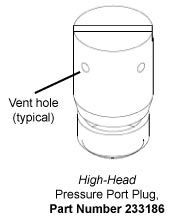APPLICATION NOTE NO. 84
Using Instruments with Druck Pressure Sensors in
Muddy or Biologically Productive Environments
Revised January 2014
![]()
This Application Note applies to many Sea-Bird instruments with Druck pressure sensors, for moored applications or other long deployments that meet either of the following conditions:
|
Note: Photo is SBE 37-SM. Pressure port details are similar for all instruments included in this application note. |
At Sea-Bird, a pressure port plug with a small (0.042-inch diameter)
vent hole in the center is inserted in the pressure sensor port. The vent
hole allows hydrostatic pressure to be transmitted to the pressure sensor
inside the instrument.
|
 |
Sea-Bird developed a high-head pressure port plug,
Part Number 233186, for deployment in
muddy and/or biologically productive environments. The high-head plug
extends beyond the surface of the instrument end cap, and has four
horizontal vent holes connecting internally to a vertical vent hole.
Note: The head-head pressure
port plug cannot be used with: |
High-Head Pressure Port Plug Installation
Note: Until the early 2000's, Sea-Bird filled the pressure port with silicon oil at the factory. For Druck pressure sensors, we determined that this was unnecessary, and no longer do so. It is not necessary to refill the oil in the field. However, for Paine or Paroscientific Digiquartz pressure sensors, the pressure port does need to be refilled with silicon oil. Please contact Sea-Bird with the serial number of your instrument if you are unsure of the type of pressure sensor installed in your instrument.
| Date | Description |
| July 2006 | Initial release. |
| January 2014 | Clarify that not applicable to newer pumped MicroCATs, plus all IDO and ODO MicroCATs, because pressure sensor is under the clamp. |
![]()
Sea-Bird Home Phone: (+1) 425-643-9866 E-mail: seabird@seabird.com